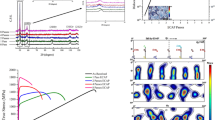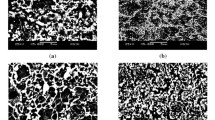Abstract
A Fe–20.1Mn–1.23Si–1.72Al–0.5C TWIP steel with ultrafine grain structure was successfully processed through equal channel angular pressing (ECAP) at warm temperature up to four passes following the B C route. The microstructure evolution was characterized by electron backscattered diffraction to obtain the grain maps, which revealed an obvious reduction in grain size, as well as a decrease in the twin fraction, with increasing number of ECAP passes. The texture evolution during ECAP was analyzed by orientation distribution function. The results show that the annealed material presents brass (B) as dominant component. After ECAP, the one pass sample presents A 1* and A 2* as the strongest components, while the two passes and four passes samples change gradually toward \( B/\bar{B} \) components. TEM analysis shows that all samples present twins. The twin thickness is reduced with increasing the number of ECAP passes. Nano-twins, as a result of secondary twinning, are also observed in the one and two passes samples. In the four passes sample, the microstructure is extensively refined by the joint action of ultrafine subgrains, grains and twins. The mechanical behavior was studied by tensile samples, and it was found that the yield strength and the ultimate tensile strength are significantly enhanced at increasing number of ECAP passes. Although the ductility and strain hardening capability are reduced with ECAP process, the present TWIP steel shows significant uniform deformation periods with positive work hardening rates.















Similar content being viewed by others
References
Soulami A, Choi KS, Shen YF, Liu WN, Sun X, Khaleel MA (2011) On deformation twinning in a 17.5% Mn–TWIP steel: a physically based phenomenological model. Mater Sci Eng A 528:1402–1408
Frommeyer G, Brux U, Neumann P (2003) Supra-ductile and high-strength manganese-TRIP/TWIP steels for high energy absorption purposes. ISIJ Int 43:438–446
Grassel O, Kruger L, Frommeyer G, Meyer LW (2000) High strength Fe–Mn–(Al, Si) TRIP/TWIP steels development-properties-application. Int J Plast 16:1391–1409
Vercammen S, Blanpai B, Cooman BC, Wollants P (2004) Cold rolling behaviour of an austenitic Fe–30Mn–3Al–3Si TWIP-steel: the importance of deformation twinning. Acta Mater 52:2005–2012
Allain S, Chateau JP, Bouaziz O, Migot S, Guelton N (2004) Correlations between the calculated stacking fault energy and the plasticity mechanisms in Fe–Mn–C alloys. Mater Sci Eng A387–389:158–162
Bouaziz O, Guelton N (2001) Modelling of TWIP effect on work-hardening. Mater Sci Eng A319–321:246–249
Shiekhelsouk MN, Favier V, Inal K, Cherkaoui M (2009) Modelling the behaviour of polycrystalline austenitic steel with twinning-induced plasticity effect. Int J Plast 25:105–133
Rahman KM, Vorontsov VA, Dye D (2015) The effect of grain size on the twin initiation stress in a TWIP steel. Acta Mater 89:247–257
Ueji R, Tsuchida N, Terada D, Tsuji N, Tanaka Y, Takemura A, Kunishige K (2008) Tensile properties and twinning behavior of high manganese austenitic steel with fine-grained structure. Scr Mater 59:963–966
Danaf EE, Kalidindi SR, Doherty RD (2001) Influence of deformation path on the strain hardening behavior and microstructure evolution in low SFE FCC metals. Int J Plast 17:1245–1265
Tewary NK, Ghosh SK, Bera S, Chakrabarti D, Chatterjee S (2014) Influence of cold rolling on microstructure, texture and mechanical properties of low carbon high Mn TWIP steel. Mater Sci Eng A 615:405–415
Bouaziz O, Allain S, Scott C (2008) Effect of grain and twin boundaries on the hardening mechanisms of twinning-induced plasticity steels. Scr Mater 58:484–487
Matoso MS, Figueiredo RB, Kawasaki M, Santos DB, Langdon TG (2012) Processing a twinning-induced plasticity steel by high-pressure torsion. Scr Mater 67:649–652
Abramova MM, Enikeev NA, Kim JG, Valiev RZ, Karavaeva MV, Kim HS (2016) Structural and phase transformation in a TWIP steel subjected to high pressure torsion. Mater Lett 166:321–324
Bagherpour E, Reihanian M, Ebrahimi R (2012) On the capability of severe plastic deformation of twining induced plasticity (TWIP) steel. Mater Des 36:391–395
Timokhina IB, Medvedev A, Lapovok R (2014) Severe plastic deformation of a TWIP steel. Mater Sci Eng A 593:163–169
Haase C, Kremer O, Hu WP, Ingendahl T, Lapovok R, Molodov DA (2016) Equal-channel angular pressing and annealing of a twinning-induced plasticity steel: microstructure, texture, and mechanical properties. Acta Mater 107:239–253
Saha R, Ueji R, Tsuji N (2013) Fully recrystallized nanostructure fabricated without severe plastic deformation in high-Mn austenitic steel. Scr Mater 68(10):813–816
Bouaziz O, Allain S, Scott CP, Cugy P, Barbier D (2011) High manganese austenitic twinning induced plasticity steels: A review of the microstructure properties relationships. Curr. Opin Solid State Mater Sci 15:141–168
Kusakin P, Belyakov A, Haase C, Kaibyshev R, Molodov DA (2014) Microstructure evolution and strengthening mechanisms of Fe–23Mn–0.3C–1.5Al TWIP steel during cold rolling. Mater Sci Eng A 617(1):52–60
Bouaziz O, Scott CP, Petitgand G (2009) Nanostructured steel with high work-hardening by the exploitation of the thermal stability of mechanically induced twins. Scr Mater 60(8):714–716
Haase C, Barrales-Mora LA, Roters F, Molodov DA, Gottstein G (2014) Applying the texture analysis for optimizing thermomechanical treatment of high manganese twinning-induced plasticity steel. Acta Mater 80:327–340
Zhou P, Liang ZY, Liu RD, Huang MX (2016) Evolution of dislocations and twins in a strong and ductile nanotwinned steel. Acta Mater 111:96–107
Li L, Hsu TY (1997) Gibbs free energy evaluation of the fcc(γ) and hcp(ε) phases in Fe–Mn–Si alloys. Calphad 21(3):443–448
Valiev RZ, Langdon TG (2006) Principles of equal-channel angular pressing as a processing tool for grain refinement. Prog Mater Sci 51:881–981
Iwahashi Y, Horita Z, Nemoto M, Langdon TG (1997) An investigation of microstructural evolution during equal-channel angular pressing. Acta Mater 45:4733–4741
He W, Ma W, Pantleon W (2008) Microstructure of individual grains in cold-rolled aluminium from orientation inhomogeneities resolved by electron backscattering diffraction. Mater Sci Eng A 494:21–27
Frommeyer G, Drewes EJ, Engl B (2000) Physical and mechanical properties of iron-aluminium-(Mn, Si) lightweight steels. Rev Metall 97(10):1245–1253
Raabe D (2003) Overview of basic types of hot rolling textures of steels. Steel Res Int 74:327–337
Suwas S, Toth LS, Fundenberger JJ, Grosdidier T, Skrotzki W (2005) Texture evolution in FCC metals during equal channel angular extrusion (ECAE) as a function of stacking fault energy. Sol State Phenom 105:345–350
Vercammen S, Blanpain B, Cooman BCD, Wollants P (2004) Cold rolling behaviour of an austenitic Fe–30Mn–3Al–3Si TWIP-steel: the importance of deformation twinning. Acta Mater 52(7):2005–2012
Bracke L, Verbeken K, Kestens L, Penning J (2009) Microstructure and texture evolution during cold rolling and annealing of a high Mn TWIP steel. Acta Mater 57(5):1512–1524
Haase C, Chowdhury SG, Barrales-Mora LA, Molodov DA, Gottstein G (2013) On the relation of microstructure and texture evolution in an austenitic Fe–28Mn–02.8C TWIP steel during cold rolling. Metall Mater Trans A 44(2):911–922
Hirsch J, Lucke K, Hatherly M (1988) Overview no. 76: mechanism of deformation and development of rolling textures in polycrystalline f.c.c. metals—III. The influence of slip inhomogeneities and twinning. Acta Metall 36:2905–2927
Saleh AA, Pereloma EV, Gazder AA (2011) Texture evolution of cold rolled and annealed Fe–24Mn–3Al–2Si–1Ni–0.06C TWIP steel. Mater Sci Eng A 528:4537–4549
Beyerlein IJ, Toth LS (2009) Texture evolution in equal-channel angular extrusion. Prog Mater Sci 54:427–510
Suwas S, Massion RA, Toth LS, Eberhardt A, Fundenberger JJ, Skrotzki W (2006) Evolution of crystallographic texture during equal channel angular extrusion of copper: the role of material variables. Metall Mater Trans A 37:739–753
Higuera-Cobos OF, Berrios-Ortiz JA, Cabrera JM (2014) Texture and fatigue behavior of ultrafine grained copper produced by ECAP. Mater Sci Eng A 609:273–282
Skrotzky W, Scheerbaum N, Oertel CG, Arrufat-Massion R, Suwas S, Toth LS (2007) Microstructure and texture gradient in copper deformed by equal channel angular extrusion. Acta Mater 55:2013–2024
Li S, Beyerlein IJ, Alexander DJ, Vogel SC (2005) Texture evolution during multipass equal channel angular extrusion of copper: neutron diffraction characterization and polycrystal modelling. Acta Mater 53:2111–2121
Benito JA, Cobo R, Lei W, Calvo J, Cabrera JM (2016) Stress–strain response and microstructural evolution of a FeMnCAl TWIP steel during tension–compression tests. Mater Sci Eng A 655:310–320
Gil-Sevillano J (2009) An alternative model for the strain hardening of FCC alloys that twin, validated for twinning-induced plasticity steel. Scr Mater 60:336–339
Barbier D, Gey N, Allain S, Bozzolo N, Humbert M (2009) Analysis of the tensile behavior of a TWIP steel based on the texture and microstructure evolutions. Mater Sci Eng A 500:196–206
Idrissi H, Renard K, Ryelandt L, Schryvers D, Jacques PJ (2010) On the mechanism of twin formation in Fe–Mn–C TWIP steels. Acta Mater 58:2464–2476
Qu S, An XH, Yang HJ, Huang CX, Yang G, Zang QS, Wang ZG, Wu SD, Zhang ZF (2009) Microstructural evolution and mechanical properties of Cu–Al alloys subjected to equal channel angular pressing. Acta Mater 57:1586–1601
Hughes DA, Lebensohn RA, Wenk HR, Kumar A (2000) Stacking fault energy and microstructure effects on torsion texture evolution. Proc R Soc A 456(1996):921–953
Jin JE, Lee YK (2009) Strain hardening behavior of a Fe–18Mn–0.6C–1.5Al TWIP steel. Mater Sci Eng A 527:157–161
Jin JE, Lee YK (2012) Effects of Al on microstructure and tensile properties of C-bearing high Mn TWIP steel. Acta Mater 60:1680–1688
Gutierrez-Urrutia I, Raabe D (2011) Dislocation and twin substructure evolution during strain hardening of an Fe–22 wt% Mn–0.6 wt% C TWIP steel observed by electron channeling contrast imaging. Acta Mater 59:6449–6462
Estrin Y, Vinogradov A (2013) Extreme grain refinement by severe plastic deformation: a wealth of challenging science. Acta Mater 61:782–817
Barbier D, Favier V, Bolle B (2012) Modelling the deformation textures and microstructural evolutions of a Fe–Mn–C TWIP steel during tensile and shear testing. Mater Sci and Eng A 540:212–225
Chowdhury SG, Gubizca J, Mahato B, Chinh NQ, Hegedus Z, Langdon TG (2011) Texture evolution during room temperature ageing of silver processed by equal-channel angular pressing. Scr Mater 64:1007–1010
Gazder AA, Torre FD, Gu CF, Davies CHJ, Pereloma EV (2006) Microstructure and texture evolution of BCC and FCC metals subjected to equal channel angular extrusion. Mater Sci Eng 55:126–139
Skrotzki W, Scheerbaum N, Oertel CG, Brokmeier HG, Suwas S, Toth LS (2005) Texture gradient in ECAP silver measured by synchrotron radiation. Mater Sci Forum 495–497:821–826
Suwas S, Toth LS, Fundenberger JJ, Eberhardt A, Skrotzki W (2003) Evolution of crystallographic texture during equal channel angular extrusion of silver. Scr Mater 49:1203–1206
Beyerlein IJ, Toth LS, Tomé CN, Suwas S (2007) Role of twinning on texture evolution of silver during equal channel angular extrusion. Philos Mag 87:885–906
Acknowledgements
The present work has been financially supported by China Scholarship Council (CSC) and the Spanish Ministry of Economy and Competitiveness through Project MAT2014-59419-C3-1-R.
Author information
Authors and Affiliations
Corresponding author
Rights and permissions
About this article
Cite this article
Wang, L., Benito, J.A., Calvo, J. et al. Equal channel angular pressing of a TWIP steel: microstructure and mechanical response. J Mater Sci 52, 6291–6309 (2017). https://doi.org/10.1007/s10853-017-0862-7
Received:
Accepted:
Published:
Issue Date:
DOI: https://doi.org/10.1007/s10853-017-0862-7




